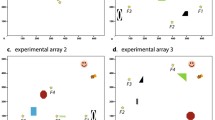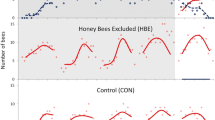Abstract
Animals must continuously choose among various available options to exploit the most profitable resource. They also need to keep themselves updated about the values of all available options, since their relative values can change quickly due to depletion or exploitation by competitors. While the sampling and decision rules by which foragers profitably exploit a flower patch have attracted a great deal of attention in theory and experiments with bumble bees, similar rules for honey bee foragers, which face similar foraging challenges, are not as well studied. By presenting foragers of the honey bee Apis cerana with choice tests in a foraging arena and recording their behavior, we investigate possible sampling and decision rules that the foragers use to choose one option over another and to track other options. We show that a large part of the sampling and decision-making process of a foraging honey bee can be explained by decomposing the choice behavior into dichotomous decision points and incorporating the cost of sampling. The results suggest that a honey bee forager, by using a few simple rules as part of a Bayesian inference process, is able to effectively deal with the complex task of successfully exploiting foraging patches that consist of dynamic and multiple options.






Similar content being viewed by others
References
Banschbach VS (1994) Colour association influences honey bee choice between sucrose concentrations. Comp Physiol A 175:107–114
Buchanan GM, Bitterman ME (1988) Learning in honeybees as a function of amount and frequency of reward. Anim Learn Behav 16:247–255
Cartar RV (2004) Resource-tracking by bumble bees: responses to plant-level differences in quality. Ecology 85:2764–2771
Chittka L, Gumbert A, Kunze, J (1997) Foraging dynamics of bumble bees: correlates of movements within and between plant species. Behav Ecol 8:239–249
Davison M, McCarthy D (1988) The matching law: a research review. Lawrence Erlbaum Associates, Hillsdale, NJ
Deneubourg JL, Pasteels JM, Verhaeghe JC (1983) Probabilistic behaviour in ants: a strategy of errors? J Theor Biol 105:259–271
Dukas R, Real LA (1993) Effect of recent experiences on foraging decisions by bumble bees. Oecologia 94:244–246
Greggers U, Menzel R (1993) Memory dynamics and foraging strategies of honeybees. Behav Ecol Sociobiol 32:17–29
Greggers U, Mauelshagen J (1997) Matching behavior of honeybees in a multiple-choice situation: the differential effect of environmental stimuli on the choice process. Anim Learn Behav 25:458
Heinrich B (1976) The foraging specialization of individual bumblebees. Ecol Monogr 46:105–128
Heinrich B (1979) “Majoring” and “minoring” by foraging bumblebees, Bombus vagans: an experimental analysis. Ecology 60:245–255
Herrnstein RJ (1997) The matching law: papers in psychology and economics. Harvard University Press, Cambridge, MA
Inglis IR, Langton S, Forkman B, Lazarus J (2001) An information primacy model of exploratory and foraging behaviour. Anim Behav 62:543–557
Keasar T, Rashkovich E, Cohen D, Shmida A (2002) Bees in two-armed bandit situations: foraging choices and possible decision mechanisms. Behav Ecol 13:757–765
Koops MA (2004) Reliability and the value of information. Anim Behav 67:103–111
Langen TA (1999) How western scrub-jays select a nut: effects of the number of options, variation in nut size, and social competition among foragers. Anim Cogn 2:223–233
Loo SK, Bitterman ME (1992) Learning in honeybees (Apis mellifera) as a function of sucrose concentration. J Comp Psychol 106:29–36
Luttbeg B (2002) Assessing the robustness and optimality of alternative decision rules with varying assumptions. Anim Behav 63:805–814
Luttbeg B, Langen TA (2004). Comparing alternative models to empirical data: cognitive models of western scrub-jay foraging behavior. Am Nat 163:263–276
Pyke GH (1979) Optimal foraging in bumblebees: rule of movement between flowers within inflorescences. Anim Behav 27:1167–1181
Real LA (1992) Information processing and the evolutionary ecology of cognitive architecture. 140:S108–S145
Shafir S (1994) Intransitivity of preferences in honey bees: support for ‘comparative’ evaluation of foraging options. Anim Behav 48:55–67
Thuijsman F, Peleg B, Amitai M, Shmida A (1995) Automata, matching and foraging behavior of bees. J Theor Biol 175:305–316
Waddington KW, Gottlieb N (1990) Actual vs perceived profitability: a study of floral choice of honey bees. J Insect Behav 3:429–441
Acknowledgements
We would like to thank the Animal Behavior Society for financial support and R. Gadagkar for facilities, both of which made this study possible. Many helpful comments from Tom Waite, Cynthia Schuck-Paim and two anonymous referees substantially improved the content and clarity of the manuscript.
Author information
Authors and Affiliations
Corresponding author
Rights and permissions
About this article
Cite this article
Naug, D., Arathi, H.S. Sampling and decision rules used by honey bees in a foraging arena. Anim Cogn 10, 117–124 (2007). https://doi.org/10.1007/s10071-006-0044-5
Received:
Revised:
Accepted:
Published:
Issue Date:
DOI: https://doi.org/10.1007/s10071-006-0044-5




